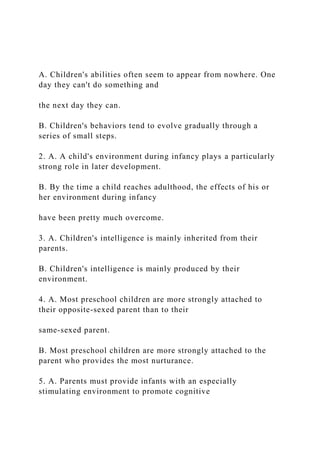A. Childrens abilities often seem to appear from nowhere. One d.docx
A. Children's abilities often seem to appear from nowhere. One day they can't do something and the next day they can. B. Children's behaviors tend to evolve gradually through a series of small steps. 2. A. A child's environment during infancy plays a particularly strong role in later development. B. By the time a child reaches adulthood, the effects of his or her environment during infancy have been pretty much overcome. 3. A. Children's intelligence is mainly inherited from their parents. B. Children's intelligence is mainly produced by their environment. 4. A. Most preschool children are more strongly attached to their opposite-sexed parent than to their same-sexed parent. B. Most preschool children are more strongly attached to the parent who provides the most nurturance. 5. A. Parents must provide infants with an especially stimulating environment to promote cognitive development. B. Infants actively seek stimulation and receive enough for good cognitive development from most normal environments. 6. A. Children think about the world in a completely different way than adults do. B. Children's minds are basically like adults' minds, except that they don't know as much yet. 7. A. Children learn most behavior by imitating adults and receiving approval for some things they do and disapproval for others. B. Children's behavior seems to be based on some inner drive; it doesn't really matter whether others approve of what they do. 8. A. Most psychological problems in adulthood are caused by heredity. B. Most psychological problems in adulthood are caused by the environments people grow up in. 9. A. Children's relationships with their parents determine what their later relationships with other people will be like. B. Each type of relationship is different; adult relationships aren't influenced much by people's relationships with their parents. 10. A. Parents should be especially careful about how they wean and toilet train their children because these events have a big influence on people's personalities. B. Weaning and toilet training are no more important in children's development than anything else that happens in infancy. [Adapted from a quiz developed by Michael Livingston, St. John's University, Collegeville, MN.] 15 .

Recommended
Recommended
More Related Content
Similar to A. Childrens abilities often seem to appear from nowhere. One d.docx
Similar to A. Childrens abilities often seem to appear from nowhere. One d.docx (6)
More from bartholomeocoombs
More from bartholomeocoombs (20)
Recently uploaded
Recently uploaded (20)
A. Childrens abilities often seem to appear from nowhere. One d.docx
- 1. A. Children's abilities often seem to appear from nowhere. One day they can't do something and the next day they can. B. Children's behaviors tend to evolve gradually through a series of small steps. 2. A. A child's environment during infancy plays a particularly strong role in later development. B. By the time a child reaches adulthood, the effects of his or her environment during infancy have been pretty much overcome. 3. A. Children's intelligence is mainly inherited from their parents. B. Children's intelligence is mainly produced by their environment. 4. A. Most preschool children are more strongly attached to their opposite-sexed parent than to their same-sexed parent. B. Most preschool children are more strongly attached to the parent who provides the most nurturance. 5. A. Parents must provide infants with an especially stimulating environment to promote cognitive
- 2. development. B. Infants actively seek stimulation and receive enough for good cognitive development from most normal environments. 6. A. Children think about the world in a completely different way than adults do. B. Children's minds are basically like adults' minds, except that they don't know as much yet. 7. A. Children learn most behavior by imitating adults and receiving approval for some things they do and disapproval for others. B. Children's behavior seems to be based on some inner drive; it doesn't really matter whether others approve of what they do. 8. A. Most psychological problems in adulthood are caused by heredity. B. Most psychological problems in adulthood are caused by the environments people grow up in. 9. A. Children's relationships with their parents determine what their later relationships with other people will be like. B. Each type of relationship is different; adult relationships aren't influenced much by people's relationships with their parents. 10. A. Parents should be especially careful about how they wean and toilet train their children
- 3. because these events have a big influence on people's personalities. B. Weaning and toilet training are no more important in children's development than anything else that happens in infancy. [Adapted from a quiz developed by Michael Livingston, St. John's University, Collegeville, MN.] 15